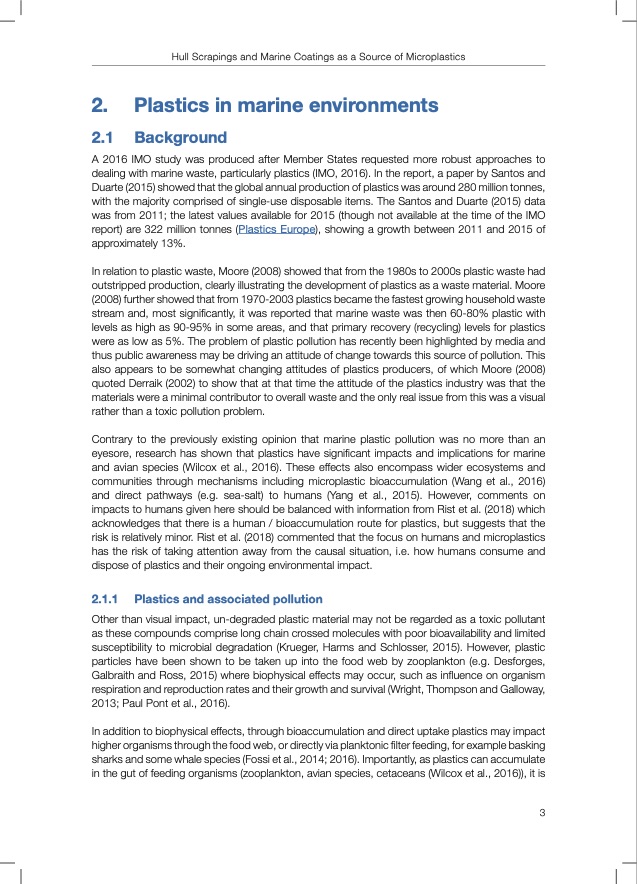
PDF Publication Title:
Text from PDF Page: 012
Hull Scrapings and Marine Coatings as a Source of Microplastics 2. Plastics in marine environments 2.1 Background A 2016 IMO study was produced after Member States requested more robust approaches to dealing with marine waste, particularly plastics (IMO, 2016). In the report, a paper by Santos and Duarte (2015) showed that the global annual production of plastics was around 280 million tonnes, with the majority comprised of single-use disposable items. The Santos and Duarte (2015) data was from 2011; the latest values available for 2015 (though not available at the time of the IMO report) are 322 million tonnes (Plastics Europe), showing a growth between 2011 and 2015 of approximately 13%. In relation to plastic waste, Moore (2008) showed that from the 1980s to 2000s plastic waste had outstripped production, clearly illustrating the development of plastics as a waste material. Moore (2008) further showed that from 1970-2003 plastics became the fastest growing household waste stream and, most significantly, it was reported that marine waste was then 60-80% plastic with levels as high as 90-95% in some areas, and that primary recovery (recycling) levels for plastics were as low as 5%. The problem of plastic pollution has recently been highlighted by media and thus public awareness may be driving an attitude of change towards this source of pollution. This also appears to be somewhat changing attitudes of plastics producers, of which Moore (2008) quoted Derraik (2002) to show that at that time the attitude of the plastics industry was that the materials were a minimal contributor to overall waste and the only real issue from this was a visual rather than a toxic pollution problem. Contrary to the previously existing opinion that marine plastic pollution was no more than an eyesore, research has shown that plastics have significant impacts and implications for marine and avian species (Wilcox et al., 2016). These effects also encompass wider ecosystems and communities through mechanisms including microplastic bioaccumulation (Wang et al., 2016) and direct pathways (e.g. sea-salt) to humans (Yang et al., 2015). However, comments on impacts to humans given here should be balanced with information from Rist et al. (2018) which acknowledges that there is a human / bioaccumulation route for plastics, but suggests that the risk is relatively minor. Rist et al. (2018) commented that the focus on humans and microplastics has the risk of taking attention away from the causal situation, i.e. how humans consume and dispose of plastics and their ongoing environmental impact. 2.1.1 Plastics and associated pollution Other than visual impact, un-degraded plastic material may not be regarded as a toxic pollutant as these compounds comprise long chain crossed molecules with poor bioavailability and limited susceptibility to microbial degradation (Krueger, Harms and Schlosser, 2015). However, plastic particles have been shown to be taken up into the food web by zooplankton (e.g. Desforges, Galbraith and Ross, 2015) where biophysical effects may occur, such as influence on organism respiration and reproduction rates and their growth and survival (Wright, Thompson and Galloway, 2013; Paul Pont et al., 2016). In addition to biophysical effects, through bioaccumulation and direct uptake plastics may impact higher organisms through the food web, or directly via planktonic filter feeding, for example basking sharks and some whale species (Fossi et al., 2014; 2016). Importantly, as plastics can accumulate in the gut of feeding organisms (zooplankton, avian species, cetaceans (Wilcox et al., 2016)), it is 3PDF Image | HULL SCRAPINGS AND MARINE COATINGS AS A SOURCE OF MICROPLASTICS

PDF Search Title:
HULL SCRAPINGS AND MARINE COATINGS AS A SOURCE OF MICROPLASTICSOriginal File Name Searched:
Hull-Scrapings-report.pdfDIY PDF Search: Google It | Yahoo | Bing
Development of a solar powered Electric Ship The Electricship website originally started off as a project to develop a comprehensive renewable, affordable, modular electric ship... More Info
Modular Boat Hull Composite The case for a unsinkable, modular composite hybrid boat hull... More Info
MS Burgenstock Hybrid Electric Catamaran Lake Lucerne Unique shuttle servicing Lucerne to the Burgenstock Resort... More Info
Ground Power Unit GPU Powered by Lithium Ion Batteries The goal of the Ground Power Unit is to provide a readily accessible, modular, ready-to-power solution for remote power... More Info
| CONTACT TEL: 608-238-6001 Email: greg@electricship.com | RSS | AMP |